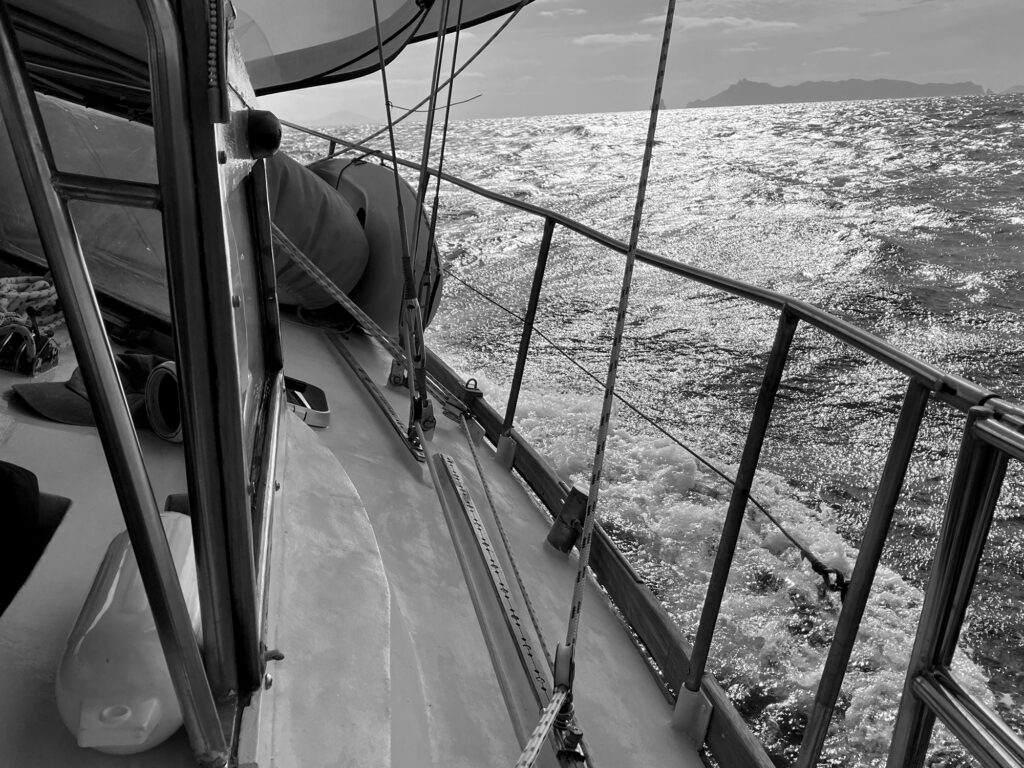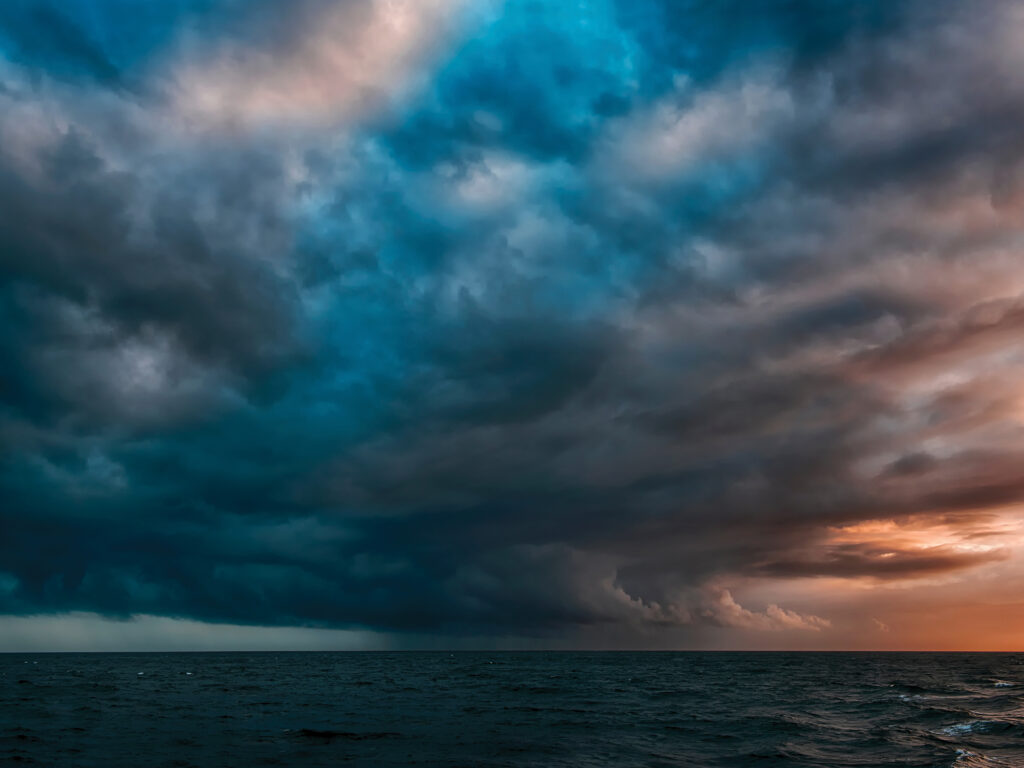SB Television
Weather Windows: Lessons in Planning and Patience at Sea
 After a storm’s fury, the watch demands full alertness, as sailors know conditions can shift in an instant and vigilance is their best safeguard.
Courtesy Lin Pardey
After a storm’s fury, the watch demands full alertness, as sailors know conditions can shift in an instant and vigilance is their best safeguard.
Courtesy Lin Pardey
“This is the worst trip… I’ve ever been on.” I sing the chorus to “Sloop John B.” My voice rings out loud and clear.
Just 15 feet from me, my partner, David, is sound asleep. But no matter how loud I sing, I know I won’t disturb him. My voice is nothing compared to the sound of wind whistling through the rigging, the crash of water rushing across the foredeck as Sahula shoulders her way through wave after wave.
For the past three days, we have been taking turns hand-steering as we fight our way toward Australia. A polar dip has caused two different weather systems to unexpectedly overlap each other, creating messy cross seas. Without our assistance, the windvane self-steering gear struggles to keep Sahula close hauled in the near-gale-force winds.
We are both tired. The work of sitting behind the wheel in these sloppy seas is physically demanding but also boring. We have shortened our normal night watches to just two hours. Sleep comes instantly when I get down below, strip off my foul-weather gear and climb into the leeward settee for my off-watch. David is the same. And though I am technically getting enough rest, I still need to do something to keep me fully awake and alert as day 13 of what is usually an eight- or nine-day passage slowly dawns.
The Tasman Sea doesn’t have the best of reputations. Only one of the five previous crossings I have made between New Zealand and Australia could be considered pleasurable. The others ranged from plain hard work to one of the worst passages I recall making with my husband, Larry. Thus, I had been determined to choose a good weather window for this sixth crossing.
The month of May is usually the best time to head westward from New Zealand. The seawater temperature has cooled down from its summer high, so the risk of tropical cyclones has fallen right off. Winter gales have not yet begun rampaging across the Tasman Sea. Several weeks earlier, I’d started watching the online weather forecasts on Windy and PredictWind, plus Met Office New Zealand. I was looking for a time when the center of a low pressure system crossing the Tasman was just passing the North Island of New Zealand, and before the next low pressure system shoved its way between Tasmania and mainland Australia. Potentially good departure windows seemed to appear every fifth or sixth day.
Ten days before the end of May, we’d finally taken care of all our landside obligations. We’d enjoyed a brisk sail 120 miles north toward Opua, the customs clearance port, to complete the formalities of leaving New Zealand. But before we cleared, both of us were looking forward to finding a quiet anchorage among the myriad islands near Opua where we could spend a few days recovering from the rush to set sail while we waited for our weather window to open.
Weather patterns are complex. Two-day forecasts are reliable, but longer-term predictions are educated guesses. Windows open and close.
Only hours from Opua, our plans were derailed. My scour of weather sites indicated the exact pattern I’d hoped for was already forming up. If we could clear customs, make a dash to the local grocery store for fresh fruit and vegetables and set sail the next morning, we’d have a fine chance to reach northwestward with fresh, favorable winds for four days, and then catch a trade-wind sleigh ride westward.
“What about catching the following window?” David suggested. “Be nice to do nothing for four or five days.”
It was tempting. Then I looked at the weather sites again. “This front is moving slower than usual. Could be 10 days before another window opens up,” I answered.
As I rushed about buying provisions, then doing the pre-departure paperwork, David topped up Sahula’s water tanks, secured the deck strap for our harness lines, set up the para-anchor and its bridle so we could launch it without having to go on the foredeck, and then deflated the tender and secured it on the aft deck.
 Dark clouds gather on the horizon, a reminder that even with the best forecasts, sailors must always prepare for the next test of seamanship.
cherylvb/stock.adobe.com
Dark clouds gather on the horizon, a reminder that even with the best forecasts, sailors must always prepare for the next test of seamanship.
cherylvb/stock.adobe.com
As I was walking back down the dock toward Sahula, I met Doug, a Kiwi cruiser I knew quite well. He asked when we planned to set sail.
“In the morning. Nice weather window.”
He replied: “Cruising is a lot easier and safer now than when you and Larry set off. Now we’ve got all the info we need to avoid sailing into heavy weather.”
I recall those words just as a particularly hard gust of wind adds to the cacophony of sounds and I have to swing the wheel hard over to counteract Sahula’s surging. It’s true that Larry and I had far less access to weather info as we voyaged across oceans. But in some ways, that made sailing less worrisome. When we were planning to set off across an ocean, we used pilot charts to determine the best potential times to make a passage and the most advantageous course to sail for a chance of fair winds. To determine our actual departure day, we used local radio forecasts, the TV weatherman we watched at the pub near our anchorage, and the weather synopsis printout we could find at the local port captain’s office. We’d look for a time when we’d have at least three or four days of favorable winds to clear the land. Then we prepared the boat and ourselves as best we could for whatever weather might come eight or 10 or 20 days later.
We were never truly surprised or disappointed when the weather deteriorated five days or eight or 10 days after we set sail. We just reefed down and kept the boat moving comfortably, or we hove to until conditions improved.
Now, as I struggle to stay awake, I realize David and I are fighting something that should just be accepted. I don’t wait for the end of my watch. Instead, I call down to David, “Come on up and help me get this boat hove to.” I get no protest at all. Together, we soon have the staysail furled. We’ve used the mainsheet traveler lines to haul the double reefed mainsail tight amidships, and tied the helm to leeward.
We were never truly surprised when weather deteriorated days after departure. We reefed down and kept moving or hove to until conditions improved.
Sahula slows until she is making almost no headway at all. The chartplotter shows she is now drifting downwind at about half a knot. The wind feels like it has dropped by half, and spray no longer lashes the boat. I put the kettle on to make a cup of tea while I download the latest forecast. Iridium Go! indicates the wind should start to back sometime in the next several hours.
“Don’t count on it,” David comments as he climbs into the cockpit, and released from the chore of steering, settles comfortably into a dry corner under the doghouse to watch for coastal shipping traffic.
As I climb into the bunk, I feel certain this short-term forecast will be right. I also recall what Bob McDavitt, a well-known New Zealand weather specialist and sailing router once told me: “So many factors can affect weather patterns. That means, while it is relatively easy to make accurate two-day predictions, we forecasters are just making educated guesses about what will happen four days out. You sailors have to be aware, windows may open, but windows also close.”
Less than six hours after we hove to, the wind did back. We set sail on a close reach to arrive at our destination 36 hours later, having sailed 1,370 miles in 14.5 days. No gear failures, no need to use the para-anchor, and two of those days were true dream sailing.
The rest was hard work. But now, as we meander ever so leisurely north inside the Great Barrier Reef, it is those perfect days that come most readily to mind.
After cruising more than 240,000 miles, US Sailing Hall of Fame inductee Lin Pardey is headed to sea again. Her latest book, Passages: Cape Horn and Beyond, encourages sailors to go simple, go small and go now. She is also the co-author, with her husband, Larry, of the essential Storm Tactics: Modern Methods of Heaving-to for Survival in Extreme Conditions, a must-read for anyone preparing for offshore voyaging.
The post Weather Windows: Lessons in Planning and Patience at Sea appeared first on Cruising World.
- Home
- About Us
- Write For Us / Submit Content
- Advertising And Affiliates
- Feeds And Syndication
- Contact Us
- Login
- Privacy
All Rights Reserved. Copyright , Central Coast Communications, Inc.